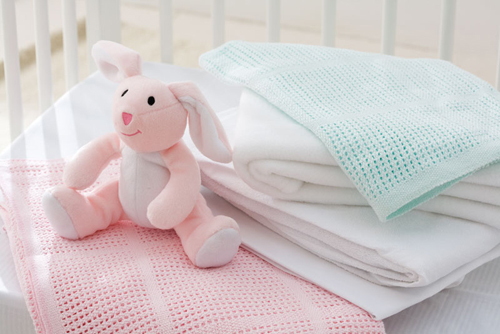Bathtime Essentials
It’s easy to get carried
away and think you need a truckload of supplies to get your tiny baby
fresh and clean; however, you probably need to buy much less than you
think.
Baby bath—choose
a sturdy plastic model that will not bend and spill its contents when
moved; fill using a hose attachment to avoid having to lift the bath in
and out of the tub; some models are specifically designed to fit into
your kitchen sink, which keeps you from having to bend over a
tub—however, after a few months, your baby will certainly outgrow this
model A kitchen or bathroom sink
lined with an old sheet (for comfort) is also effective as a baby bath
and is better for your back; or you can bring your baby into the bath or
shower with you—just be sure that you have a secure grip on him,
because he’ll be more slippery when wet Two towels,
preferably hooded to keep your baby’s head warm while you use the body
of the towel to dry him; you need two because babies often empty their
bladders or bowels after a bath, and you may have to start over Baby bath and shampoo—a
combined product can save both money and time; organic baby products
are less likely to contain chemicals that could harm your baby or cause
irritation to his tender skin A sponge—natural is best A cotton washcloth—choose one with a pattern to distract your baby for times when baths are not popular A plastic cup or small bucket—this makes it much easier to rinse hair, and can also be used as a distraction A non-slip mat—this is useful if you are bathing your baby in the big tub A thermometer—not
essential, but if you are concerned with getting the water temperature
just right, this can come in handy; otherwise, use your elbow to ensure
that water is just warm to the touch
Keeping Clean
It’s astonishing how
much mess a small baby can create, and it can help to be prepared with a
few useful items to protect his clothing and keep him clean between
baths.
Burp cloths—these
are invaluable, so invest in a whole stack: you can use them to mop up
spit up, milk, and drool, and they can be used to protect your clothes
when you feed and burp your baby Bibs—these
will protect your baby’s clothes during (and shortly after) feeding,
and also prevent spilled milk from irritating the skin around his neck;
if he’s a real drooler, he can wear them all day
Choose bibs
that are washable, and preferably ones with a wide neck that slip easily
over his head; ties and snaps may prove the undoing of you if you have
only one hand free You may wish to purchase disposable bibs for when you are traveling, or away from home Bibs
with a cloth front and waterproof backing are particularly good, since
they prevent liquid from being absorbed into your baby’s clothes
A plastic-backed mat—for
playtime, as well as feeding. If, like most babies, yours has a
tendency to explosive elimination, you’ll most definitely want to invest
in one of these; disposable mats are also available Keep a supply of thin washcloths—these can be dampened and used to clean all of your baby’s little crevices Cotton balls—keep these near the changing table—they can be useful for mopping little noses and eyes Wipes—you’ll
need these wherever you are, in or out of the house, so stock up; go
for natural, organic wipes, which are less likely to irritate your
baby’s skin
Soothers and Comfort Items
You may want to think ahead
about whether you want to use soothers such as comfort toys, blankets,
and pacifiers. These can provide an easy, way to soothe an anxious or
sleepless baby, and may even help to reduce separation anxiety as your
baby gets older. Here are some things to take into account.
Pacifiers
These are particularly effective, since they allow your child to suckle—an instinctive and calming activity Some research suggests that babies who go to sleep with pacifiers have a reduced risk of SIDS Prolonged use of pacifiers and thumb-sucking for long periods can affect your baby’s speech development and the alignment of her teeth, so limit their use Choose “orthodontic” pacifiers, which are designed to have less impact on your baby’s growing teeth Experiment with a few brands and shapes to see what your baby likes best, and make sure you choose the size appropriate to her age When you find a pacifier that works, buy several, and keep them in a plastic bag to keep them clean Remember that pacifiers need to be washed regularly, and should be discarded if they show cracks or tears
Comfort items
Choose a washable soft toy or blanket
and always use it to settle your little one to sleep, and to comfort
her when she is distressed—it will soon become something she uses to
soothe herself when you are not around Studies have found that comfort objects help children adapt better to stressful situations (such as beginning day care or moving to a new house), and cope better when they are anxious or afraid When your baby becomes attached to a particular item,
purchase at least one duplicate immediately—this can be used while the
original is in the wash, or in the event that you lose or misplace the
original To help make an item more attractive to your baby, you can wear it under your shirt for a few hours so it picks up your scent Comfort items become wonderful transitional objects when your baby is separated from you If you aren’t comfortable
having your baby become attached to an object, read her the same story
or sing her the same song when you are settling her—this will soon
become familiar and therefore a useful tool for soothing

|